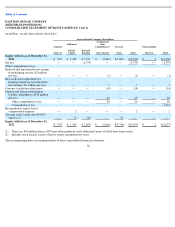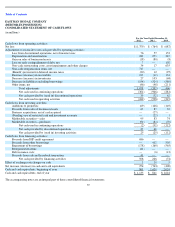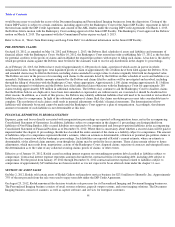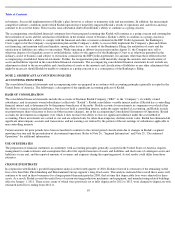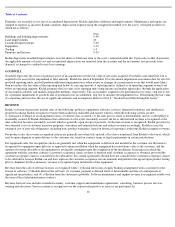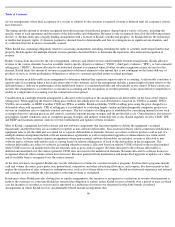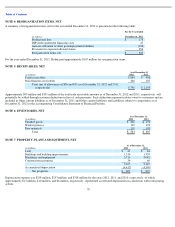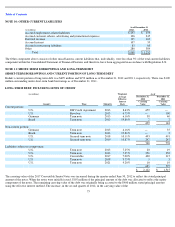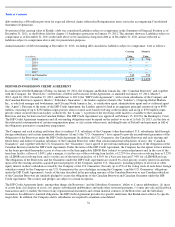Kodak 2012 Annual Report Download - page 70
Download and view the complete annual report
Please find page 70 of the 2012 Kodak annual report below. You can navigate through the pages in the report by either clicking on the pages listed below, or by using the keyword search tool below to find specific information within the annual report.
Table of Contents
service arrangements where final acceptance of a system or solution by the customer is required, revenue is deferred until all acceptance criteria
have been met.
The timing and the amount of revenue recognized from the licensing of intellectual property depend upon a variety of factors, including the
specific terms of each agreement and the nature of the deliverables and obligations. Revenue is only recognized after all of the following criteria
are met: (1) Kodak enters into a legally binding arrangement with a licensee of Kodak’s intellectual property, (2) Kodak delivers the technology
or intellectual property rights, (3) licensee payment is deemed fixed or determinable and free of contingencies or significant uncertainties, and
(4) collection from the licensee is reasonably assured.
When Kodak has continuing obligations related to a licensing arrangement, including extending the rights to currently undeveloped intellectual
property, Kodak applies the multiple element revenue guidance described below to determine the separation, allocation and recognition of
revenue.
Kodak’s transactions may involve the sale of equipment, software, and related services under multiple element arrangements. Kodak allocates
revenue to the various elements based on available vendor specific objective evidence (“VSOE”), third party evidence (“TPE”),
or best estimated
selling price (“BESP”). Revenue allocated to an individual element is recognized when all other revenue recognition criteria are met for that
element. Kodak limits the amount of revenue recognition for delivered elements to the amount that is not contingent on the future delivery of
products or services, future performance obligations or subject to customer-specified return or refund privileges.
Kodak evaluates each deliverable in an arrangement to determine whether they represent separate units of accounting. A deliverable constitutes a
separate unit of accounting when it has stand-alone value to the customer, and if the arrangement includes a general right of return relative to the
delivered item(s), delivery or performance of the undelivered item(s) is considered probable and substantially in our control. If these criteria are
not met, the arrangement is accounted for as one unit of accounting and the recognition of revenue generally occurs upon delivery/completion or
ratably as a single unit of accounting over the contractual service period.
Consideration in a multiple element arrangement is allocated at the inception of the arrangement to all deliverables on the basis of the relative
selling price. When applying the relative selling price method, the selling price for each deliverable is based on its VSOE if available, TPE if
VSOE is not available, or BESP if neither VSOE nor TPE is available. Kodak establishes VSOE of selling price using the price charged for a
deliverable when sold separately. TPE of selling price is established by evaluating largely similar and interchangeable competitor products or
services in standalone sales to similarly situated customers. The best estimate of selling price is established by considering internal factors such
as margin objectives, pricing practices and controls, customer segment pricing strategies and the product life cycle. Consideration is also given to
geographies, market conditions such as competitor pricing strategies and industry technology life cycles. Kodak regularly reviews VSOE, TPE
and BESP and maintains internal controls over the establishment and updates of these estimates.
Most of Kodak’s equipment has both software and non-software components that function together to deliver the equipment’s essential
functionality and therefore they are accounted for together as non-software deliverables. Non-essential software sold in connection with Kodak’
s
equipment sales is off-the-shelf and accounted for as separate deliverables or elements. In most cases these software products sold as part of a
multiple element arrangement include software maintenance agreements as well as unspecified upgrades or enhancements on a when-and-if-
available basis. In those multiple element arrangements where non-essential software deliverables are included, revenue is allocated to non-
software and to software deliverables each as a group based on relative selling prices of each of the deliverables in the arrangement. The
software deliverables are subject to software accounting whereby revenue is allocated based on relative VSOE or based on the residual method
when VSOE exists for all undelivered software elements such as post-contract support. Revenue allocated to the software deliverables is
deferred and amortized over the contract period if VSOE does not exist for the undelivered elements. Revenue allocated to software licenses is
recognized when all other revenue criteria have been met. Revenue generated from maintenance and unspecified upgrades or updates on a when-
and-if-available basis is recognized over the contract period.
At the time revenue is recognized, Kodak also records reductions to revenue for customer incentive programs. Such incentive programs include
cash and volume discounts, price protection, promotional, cooperative and other advertising allowances, and coupons. For those incentives that
require the estimation of sales volumes or redemption rates, such as for volume rebates or coupons, Kodak uses historical experience and internal
and customer data to estimate the sales incentive at the time revenue is recognized.
In instances where Kodak provides slotting fees or similar arrangements, this incentive is recognized as a reduction in revenue when payment is
made to the customer (or at the time Kodak has incurred the obligation, if earlier) unless Kodak receives a benefit over a period of time, in which
case the incentive is recorded as an asset and is amortized as a reduction of revenue over the period in which the benefit is realized.
Arrangements in which Kodak receives an identifiable benefit include arrangements that
66


